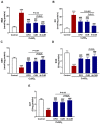Nano-Curcumin Prevents Copper Reproductive Toxicity by Attenuating Oxidative Stress and Inflammation and Improving Nrf2/HO-1 Signaling and Pituitary-Gonadal Axis in Male Rats
- PMID: 35878260
- PMCID: PMC9316697
- DOI: 10.3390/toxics10070356
Nano-Curcumin Prevents Copper Reproductive Toxicity by Attenuating Oxidative Stress and Inflammation and Improving Nrf2/HO-1 Signaling and Pituitary-Gonadal Axis in Male Rats
Abstract
Copper is essential for several cellular processes and is an important catalytic factor for many proteins. However, excess copper can provoke oxidative stress and reproductive toxicity. This study evaluated the effect of liposomal nano-curcumin (N-CUR) and CUR on testicular oxidative injury, inflammation, and apoptosis, and altered steroidogenesis and Nrf2/HO-1 signaling induced by copper sulfate (CuSO4). Rats received CuSO4 and N-CUR or CUR via oral gavage for 7 days. CuSO4 induced histopathological changes and altered pituitary-gonadal axis manifested by decreased serum gonadotropins and testosterone. Testicular steroidogenesis genes (StAR, 3β-HSD, CYP17A1, and 17β-HSD) and androgen receptor (AR) were downregulated in rats that received CuSO4. N-CUR and CUR prevented testicular tissue injury, increased circulating FSH, LH, and testosterone, and upregulated testicular steroidogenesis genes and AR. Additionally, N-CUR and CUR decreased testicular MDA, NO, NF-κB, iNOS, TNF-α, Bax, and caspase-3 while enhanced Bcl-2, Nrf2, and the antioxidants GSH, HO-1, SOD, and catalase. In conclusion, N-CUR and CUR prevented CuSO4-induced reproductive toxicity in male rats by suppressing oxidative injury and inflammatory response and boosting steroidogenesis, sex hormones, and Nrf2/HO-1 signaling. N-CUR was more effective in ameliorating tissue injury, oxidative stress, inflammation, and apoptosis and enhancing steroidogenesis and Nrf2/HO-1 than the native form.
Keywords: copper sulfate; curcumin; oxidative stress; reproductive toxicity; steroidogenesis.
Conflict of interest statement
The authors declare no conflict of interest.
Figures







Similar articles
-
Curcumin and Nano-Curcumin Mitigate Copper Neurotoxicity by Modulating Oxidative Stress, Inflammation, and Akt/GSK-3β Signaling.Molecules. 2021 Sep 15;26(18):5591. doi: 10.3390/molecules26185591. Molecules. 2021. PMID: 34577062 Free PMC article.
-
Nano-Curcumin Prevents Cardiac Injury, Oxidative Stress and Inflammation, and Modulates TLR4/NF-κB and MAPK Signaling in Copper Sulfate-Intoxicated Rats.Antioxidants (Basel). 2021 Sep 3;10(9):1414. doi: 10.3390/antiox10091414. Antioxidants (Basel). 2021. PMID: 34573046 Free PMC article.
-
Umbelliferone Inhibits Spermatogenic Defects and Testicular Injury in Lead-Intoxicated Rats by Suppressing Oxidative Stress and Inflammation, and Improving Nrf2/HO-1 Signaling.Drug Des Devel Ther. 2020 Sep 29;14:4003-4019. doi: 10.2147/DDDT.S265636. eCollection 2020. Drug Des Devel Ther. 2020. Retraction in: Drug Des Devel Ther. 2023 Apr 13;17:1153-1154. doi: 10.2147/DDDT.S416910. PMID: 33061305 Free PMC article. Retracted.
-
Acrylamide-induced hypothalamic-pituitary-gonadal axis disruption in rats: Androgenic protective roles of apigenin by restoring testicular steroidogenesis through upregulation of 17β-HSD, CYP11A1 and CYP17A1.Food Chem Toxicol. 2024 Dec;194:115078. doi: 10.1016/j.fct.2024.115078. Epub 2024 Nov 6. Food Chem Toxicol. 2024. PMID: 39515511
-
Impact of arsenic on male and female reproductive function: a review of the pathophysiology and potential therapeutic strategies.Naunyn Schmiedebergs Arch Pharmacol. 2025 Feb;398(2):1283-1297. doi: 10.1007/s00210-024-03452-6. Epub 2024 Sep 17. Naunyn Schmiedebergs Arch Pharmacol. 2025. PMID: 39287676 Review.
Cited by
-
Advances in Nrf2 Signaling Pathway by Targeted Nanostructured-Based Drug Delivery Systems.Biomedicines. 2024 Feb 9;12(2):403. doi: 10.3390/biomedicines12020403. Biomedicines. 2024. PMID: 38398005 Free PMC article. Review.
-
Associations of Metal Mixtures with Lipid Profiles: Exploring the Mediating Role of Testosterone in a Cross-Sectional Study.Biol Trace Elem Res. 2025 Jul 25. doi: 10.1007/s12011-025-04745-4. Online ahead of print. Biol Trace Elem Res. 2025. PMID: 40711747
-
Nano-Curcumin Mitigates Doxorubicin-Induced Reproductive Toxicity via Antioxidant, Anti-Apoptosis, and SIRT1-Modulating Effects in Rat Model.Toxics. 2025 Jul 8;13(7):574. doi: 10.3390/toxics13070574. Toxics. 2025. PMID: 40711019 Free PMC article.
-
Effect of nanocurcumin on fertility in murine model of polycystic ovary syndrome.Vet Res Forum. 2024;15(2):113-117. doi: 10.30466/vrf.2023.2006604.3935. Epub 2024 Feb 15. Vet Res Forum. 2024. PMID: 38465321 Free PMC article.
-
Roles of Nrf2/HO-1 and ICAM-1 in the Protective Effect of Nano-Curcumin against Copper-Induced Lung Injury.Int J Mol Sci. 2023 Sep 12;24(18):13975. doi: 10.3390/ijms241813975. Int J Mol Sci. 2023. PMID: 37762280 Free PMC article.
References
Grants and funding
LinkOut - more resources
Full Text Sources
Research Materials

